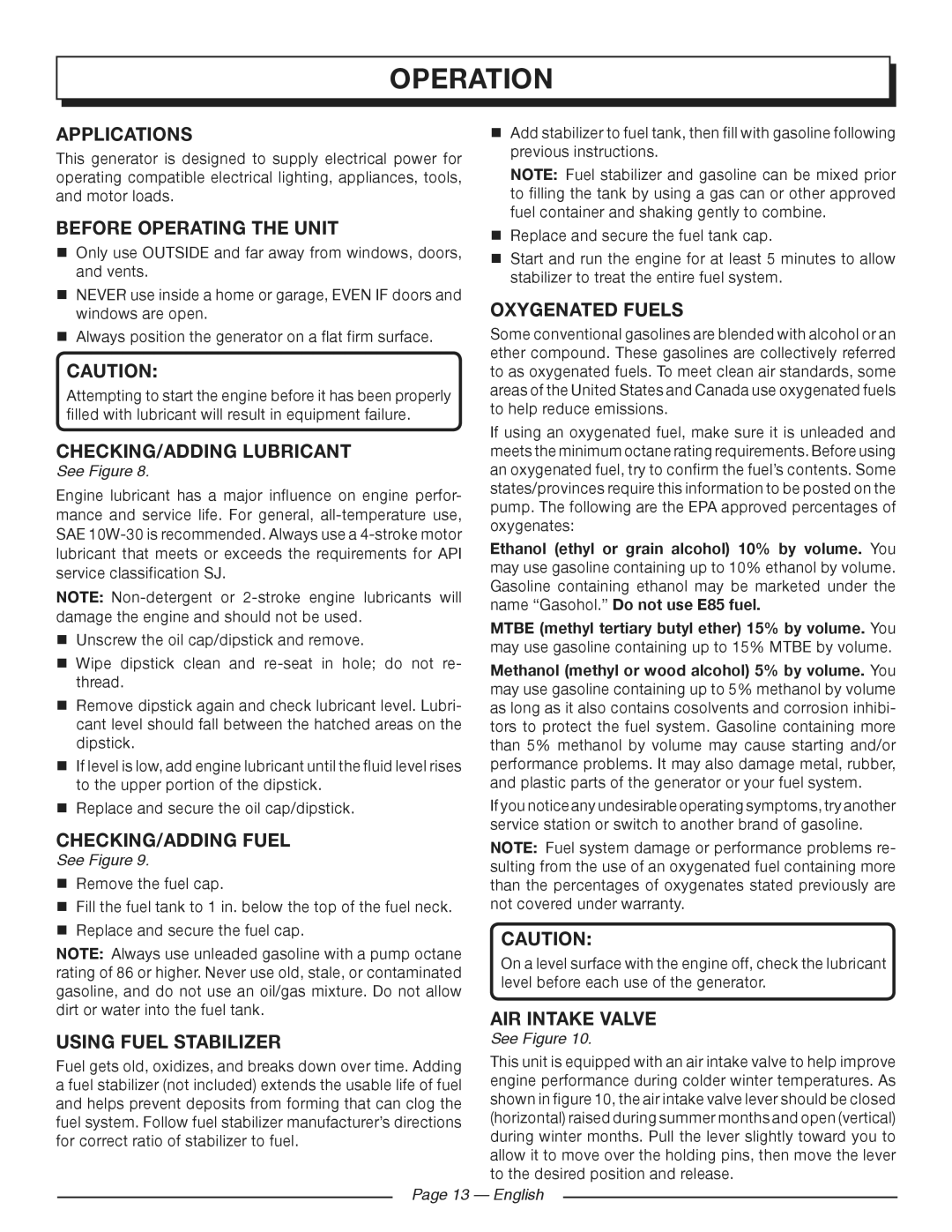
operation
APPLICATIONS
This generator is designed to supply electrical power for operating compatible electrical lighting, appliances, tools, and motor loads.
BEFORE OPERATING the UNIT
Only use OUTSIDE and far away from windows, doors, and vents.
NEVER use inside a home or garage, EVEN IF doors and windows are open.
Always position the generator on a flat firm surface.
CAUTION:
Attempting to start the engine before it has been properly filled with lubricant will result in equipment failure.
checking/adding lubricant
See Figure 8.
Engine lubricant has a major influence on engine perfor- mance and service life. For general,
NOTE:
Unscrew the oil cap/dipstick and remove.
Wipe dipstick clean and
Remove dipstick again and check lubricant level. Lubri- cant level should fall between the hatched areas on the dipstick.
If level is low, add engine lubricant until the fluid level rises to the upper portion of the dipstick.
Replace and secure the oil cap/dipstick.
checking/adding fuel
See Figure 9.
Remove the fuel cap.
Fill the fuel tank to 1 in. below the top of the fuel neck.
Replace and secure the fuel cap.
NOTE: Always use unleaded gasoline with a pump octane rating of 86 or higher. Never use old, stale, or contaminated gasoline, and do not use an oil/gas mixture. Do not allow dirt or water into the fuel tank.
using fuel stabilizer
Fuel gets old, oxidizes, and breaks down over time. Adding a fuel stabilizer (not included) extends the usable life of fuel and helps prevent deposits from forming that can clog the fuel system. Follow fuel stabilizer manufacturer’s directions for correct ratio of stabilizer to fuel.
Add stabilizer to fuel tank, then fill with gasoline following previous instructions.
NOTE: Fuel stabilizer and gasoline can be mixed prior to filling the tank by using a gas can or other approved fuel container and shaking gently to combine.
Replace and secure the fuel tank cap.
Start and run the engine for at least 5 minutes to allow stabilizer to treat the entire fuel system.
OXYGENATED FUELS
Some conventional gasolines are blended with alcohol or an ether compound. These gasolines are collectively referred to as oxygenated fuels. To meet clean air standards, some areas of the United States and Canada use oxygenated fuels to help reduce emissions.
If using an oxygenated fuel, make sure it is unleaded and meets the minimum octane rating requirements. Before using an oxygenated fuel, try to confirm the fuel’s contents. Some states/provinces require this information to be posted on the pump. The following are the EPA approved percentages of oxygenates:
Ethanol (ethyl or grain alcohol) 10% by volume. You may use gasoline containing up to 10% ethanol by volume. Gasoline containing ethanol may be marketed under the name “Gasohol.” Do not use E85 fuel.
MTBE (methyl tertiary butyl ether) 15% by volume. You may use gasoline containing up to 15% MTBE by volume.
Methanol (methyl or wood alcohol) 5% by volume. You may use gasoline containing up to 5% methanol by volume as long as it also contains cosolvents and corrosion inhibi- tors to protect the fuel system. Gasoline containing more than 5% methanol by volume may cause starting and/or performance problems. It may also damage metal, rubber, and plastic parts of the generator or your fuel system.
If you notice any undesirable operating symptoms, try another service station or switch to another brand of gasoline.
NOTE: Fuel system damage or performance problems re- sulting from the use of an oxygenated fuel containing more than the percentages of oxygenates stated previously are not covered under warranty.
CAUTION:
On a level surface with the engine off, check the lubricant level before each use of the generator.
air intake valve
See Figure 10.
This unit is equipped with an air intake valve to help improve engine performance during colder winter temperatures. As shown in figure 10, the air intake valve lever should be closed (horizontal) raised during summer months and open (vertical) during winter months. Pull the lever slightly toward you to allow it to move over the holding pins, then move the lever to the desired position and release.
Page 13 — English
